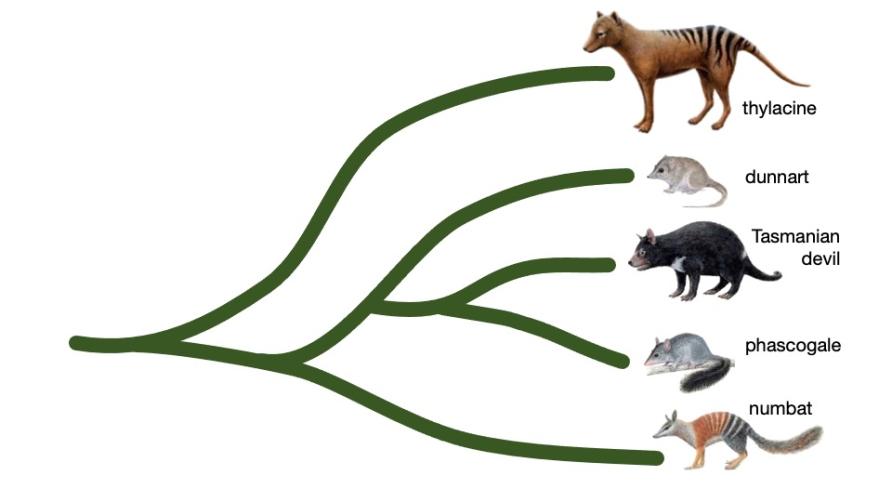‘We now have the army we need’ to bring the Tasmanian tiger back to life, says Melbourne scientist

Earlier this year a team at The University of Melbourne established a research lab dedicated to developing technologies that could bring back the Tasmanian tiger (thylacine) species, officially extinct since the 1930s.
Now, the project has partnered with US-based genetic engineering company Colossal Biosciences which will give the research team access to more DNA editing technology, as well as help from a group of world-leading scientists.
This partnership is a huge boon for the Thylacine Integrated Genetic Restoration Research (TIGRR) Lab, led by Professor Andrew Pask.
“A lot of the challenges with our efforts can be overcome by an army of scientists working on the same problems simultaneously, conducting and collaborating on the many experiments to accelerate discoveries,” he says.
“With this partnership, we will now have the army we need to make this happen.”
Professor Pask explains that, moving forward with this collaboration, TIGGR will concentrate its efforts on establishing the reproductive technologies tailored to Australian marsupials, such as IVF and gestation without a surrogate, as Colossal simultaneously deploy their CRISPR gene editing and computational biology capabilities to reproduce thylacine DNA.
But Professor Pask says the question everyone asks is ‘how long until we see a living thylacine’.
“And I’ve previously believed in ten years’ time we would have an edited cell that we could then consider progressing into making into an animal.
“With this partnership, I now believe that in ten years’ time we could have our first living baby thylacine since they were hunted to extinction close to a century ago.”
The steps involved in achieving this extraordinary feat were recently explained by Professor Pask in an article he wrote for Pursuit, a blog published by The University of Melbourne, which we have reproduced with permission:
The 9 steps to de-extincting Australia’s thylacine
by Professor Andrew Pask
Our research focuses on the marsupial, thylacine – also known as the Tasmanian tiger – which is in fact one of the best candidates for de-extinction.
Developing gene editing technologies means we can tackle issues like engineering cane toad toxin resistance into vulnerable marsupial species. While the work on marsupial cloning along with embryo growth and development can help marsupial breeding programs and species management strategies.
If we look specifically at the process to de-extinct the thylacine, there are nine key steps.
Step 1:
The good news is that this step is complete. We’ve released the thylacine genome which is basically a complete genetic blueprint or set of instructions on how to build a thylacine.
This is an essential first step in any de-extinction project, and the likelihood of de-extincting the animal is completely reliant on the quality and accuracy of that genome.
To date, the thylacine represents the highest quality extinct genome for any species (and before you ask, yes, that includes the woolly mammoth and the dodo). However, this resource can still be improved.
Since we published the thylacine genome in 2017, advances in genome sequencing technology now provide many new options to further enhance the quality and build of the genome.
Step 2:
This is another one the team have already completed. We now have the sequence for several species which represent the thylacine’s closest relatives, which includes the dunnart or marsupial mouse.
The species with the most similar DNA will provide the living cells and template genome that can then be edited to transform it into a thylacine genome.

Step 3:
This is a large bioinformatics (or computational) project that compares marsupial genomes to identify all the differences that would potentially need to be edited into the hosts genome to create a ‘thylacine’ cell. This element is currently a major objective of the new TIGRR lab.
Step 4:
This step is now in development with the TIGRR lab and the Australian Research Council. We have derived stem cells for our model marsupial species, the fat-tailed dunnart, from which a lot of the techniques needed for our thylacine de-extinction will be developed.
As part of TIGRR lab, we will establish methods that work in all marsupials. With this tool, we can effectively bio-bank diversity in ‘at-risk’ marsupial populations and protect against the loss of species that are threatened or endangered.
Steps 5 to 7:
These steps require the development of assisted reproductive technologies (ART) for marsupials and is in development with the TIGRR lab. These techniques are required to use living stem cells to make an embryo and then successfully transfer it into a host species’ uterus.
Steps 8 to 9:
This is where de-extinction efforts for marsupials have a distinct advantage over other mammals. All marsupials give birth to tiny young which complete development in the pouch while suckling milk.

Instead, as part of the de-extincting process, this can be replaced from a very young age with bottle feeding. It means that unlike other animals that require long and complicated gestation times, we can generate living animals in a range of host species and potentially without the need for a host at all.
These nine steps are likely to take a decade or more – but the work along the way will be of immediate conservation benefit for marsupials, as well as developing the technology necessary to bring back an iconic Australian animal that we hunted to extinction.



